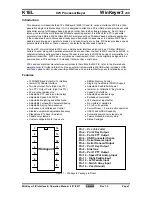
Safety edges
ENT-R, ENT-20, ENT-7, ENT-S
1
Safety edges
Assembly instructions
Application
Types of mounting
1
Safety edges (sensors) in combination with a switching unit (signal processing) are components of a safety system (protection system for person detection).
The system, or more specifically the safety edges, are used to safeguard shearing and crushing points on power-operated doors, gates and similar automatic
fixtures. The safety edges can be installed in any horizontal or vertical position, either single or in combination.
Standard
Preparing the safety edge and assembling the contact strip
2
Measuring the safety edge
2.1
Trim aluminium profile to the correct length and plan type of cable entry/exit, drill holes (countersunk) .
Trimming the rubber profile
2.2
L
L
5 – 8 mm
Using the rubber
shears, trim the rubber
profile to the desired
length L.
For the cable feed-through,
make a small hole (3,5 mm) with
hole punch pliers about
5 – 8 mm from the edge.
As an option for vertical applications
End caps on both ends
Trimming the contact strip
2.3
L - X
Trim the contact strip to length (L – X). Be sure to cut at 90° angles!
The contact strip is shorter than the rubber profile
by the length of the end pieces used:
Cable and end piece
Cable (both ends)
Types
X =
55 mm
60 mm
standard
X =
50 mm
55 mm
vertical
ENGLISH
Bottom, rubber profile closed:
- 1 end cap
- Profile chamber sealed
Bottom, rubber profile open:
-
no end cap
- switching chamber not sealed
Aluminium profile length = Rubber profile length (L)
267081C
04/15
Top, rubber profile closed:
- 1 end cap
- Profile chamber sealed
Top, rubber profile closed:
- 1 end cap
- Profile chamber sealed
The switching chamber for the contact strip must not be damaged unnecessarily as incoming water may impair the safety function
of the strip.






















